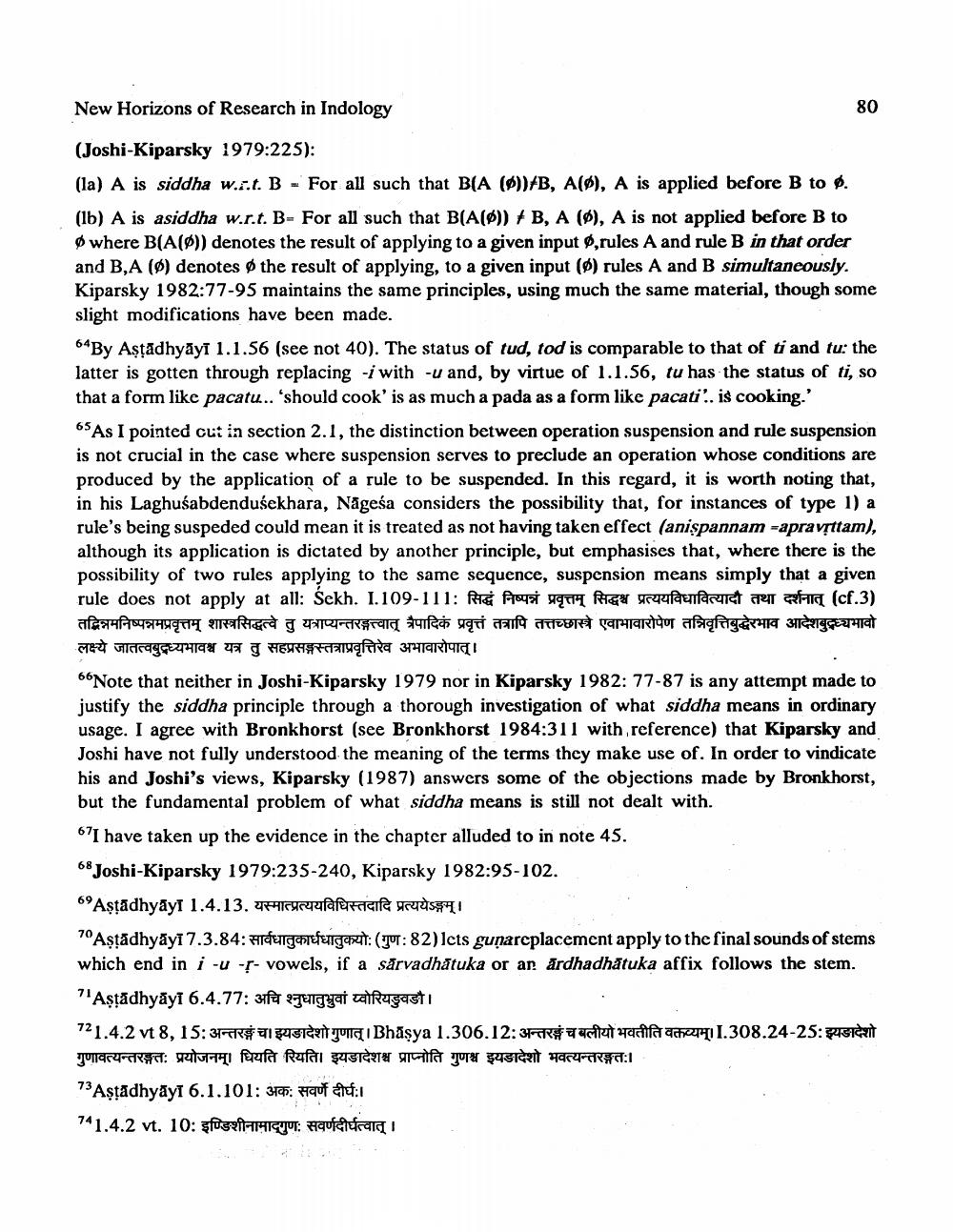________________
New Horizons of Research in Indology
80
(Joshi-Kiparsky 1979:225): (la) A is siddha w.a.t. B - For all such that BIA (Ø))4B, A(R), A is applied before B to ø. (lb) A is asiddha w.r.t. B- For all such that B(A(6)) + B, A (6), A is not applied before B to Ø where B(A(Ø)) denotes the result of applying to a given input rules A and rule B in that order and B, A (Ø) denotes the result of applying, to a given input (6) rules A and B simultaneously. Kiparsky 1982:77-95 maintains the same principles, using much the same material, though some slight modifications have been made. 64By Astādhyāyī 1.1.56 (see not 40). The status of tud, tod is comparable to that of ti and tu: the latter is gotten through replacing -i with -u and, by virtue of 1.1.56, tu has the status of ti, so that a form like pacatu... 'should cook'is as much a pada as a form like pacati... is cooking.' 65As I pointed cut in section 2.1, the distinction between operation suspension and rule suspension is not crucial in the case where suspension serves to preclude an operation whose conditions are produced by the application of a rule to be suspended. In this regard, it is worth noting that, in his Laghuśabdendusekhara, Nägeśa considers the possibility that, for instances of type 1) a rule's being suspeded could mean it is treated as not having taken effect (anispannam -apravsttam), although its application is dictated by another principle, but emphasises that, where there is the possibility of two rules applying to the same sequence, suspension means simply that a given rule does not apply at all: Sekh. I.109-111: Re Alluri uqrry fie scufufruit de atic (cf.3) तदिन्नमनिष्पन्नमप्रवृत्तम् शास्त्रसिद्धत्वे तु यत्राप्यन्तरङ्गत्वात् त्रैपादिकं प्रवृत्तं तत्रापि तत्तच्छास्त्रे एवाभावारोपेण तन्निवृत्तिबुद्धेरभाव आदेशबुयभावो लक्ष्ये जातत्वबुद्ध्यभावश्च यत्र तु सहप्रसङ्गस्तत्राप्रवृत्तिरेव अभावारोपात्। 66Note that neither in Joshi-Kiparsky 1979 nor in Kiparsky 1982: 77-87 is any attempt made to justify the siddha principle through a thorough investigation of what siddha means in ordinary usage. I agree with Bronkhorst (see Bronkhorst 1984:311 with reference) that Kiparsky and Joshi have not fully understood the meaning of the terms they make use of. In order to vindicate his and Joshi's views, Kiparsky (1987) answers some of the objections made by Bronkhorst, but the fundamental problem of what siddha means is still not dealt with. 671 have taken up the evidence in the chapter alluded to in note 45. 68 Joshi-Kiparsky 1979:235-240, Kiparsky 1982:95-102. 69Aştādhyāyt 1.4.13. Ruffertereife use! 7° Aşțădhyāyī 7.3.84: Hildurgarfurgat (goT: 82) lets gunareplacement apply to the final sounds of stems which end in i-u -r- vowels, if a sărvadhătuka or an ardhadhatuka affix follows the stem. "Aştādhyāyi 6.4.77: 31fe egurgyat tanrugasti 721.4.2 vt 8, 15:3R$TI GUSTI JUC i Bhāşya 1.306.12:3FTRTacitut wanita hamil.308.24-25:4514 गुणावत्यन्तरङ्गत: प्रयोजनम्। धियति रियति। इयडादेशश्च प्राप्नोति गुणश्च इयडादेशो भवत्यन्तरङ्गत:। 13Așțădhyāyī 6.1.101: 377: Aquf af:1 741.4.2 vt. 10: sfusait HICY: Hurlerara




